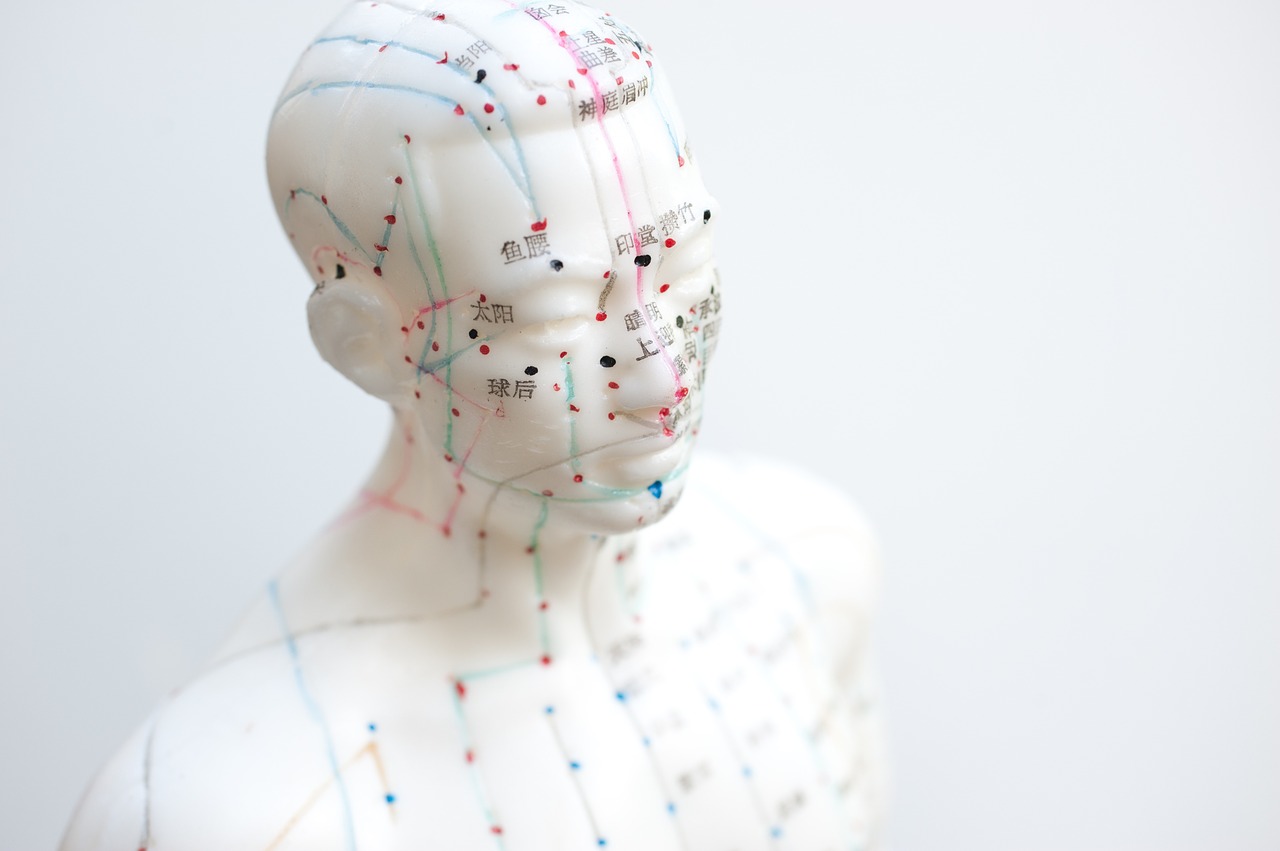
Acupuncture
Acupuncture involves the stimulation of specific points located all over the body. The stimulation of these acupoints is accomplished by various means, from inserting very thin needles into them, to heating them, massaging them, electrically stimulating them, shining laser light into them, injecting various substances into them, applying suction cups over them, and applying compounds onto the skin overlying them.
The practice of acupuncture is ancient and its origin is lost in the mists of antiquity. What we do know is that the existence of acupuncture points has been known for at least 5300 years. We know this from the discovery of “Ötzi,” a man who lived and died about 3300 BC, whose frozen body was discovered in the Alps by two hikers in 1991. Scientists examined his perfectly preserved remains and discovered 59 tiny tattoos distributed over his body and about 80% of these correspond exactly to the location of modern acupuncture points. Through the use of x-rays, the scientists also found that he had suffered from some osteoarthritis of his lumbar spine and many of the acupoints marked by the tattoos on his body are points that would be used today to treat issues related to the lower back. Although acupuncture is thought of as an Eastern practice, the discovery of Ötzi illustrates that acupuncture was known in Europe 5300 years ago, and has stood the test of time.
Acupuncture is one of the fastest growing alternative medical modalities, with record numbers of western doctors adopting it into their practices. Its use is also extremely widespread and according to the World Health Organisation, it is in fact the most widespread medical system in the world, being used in every region on Earth.
It seems to be obvious that acupuncture works, given its widespread and long history of use, but what does it do and how does it do what it does? The answer to that depends on who you ask. Westerners tend to explain the mechanisms through which acupuncture works in mechanical, biochemical terms. They point out the close correlation between the location of acupoints and known anatomical structures called neurovascular nodes. These nodes contain high concentrations of nerve fibres, fine blood and lymph vessels and mast cells. Westerners tend to attribute the effects of acupuncture to the tiny injuries caused by the insertion of needles into the tissues. The stimulation of blood flow, the release of endorphins and the activation of the immune system are cited as the primary modes of action of acupuncture. These are then responsible for the healing, relaxation, pain relief and improved regulation that result.
In addition to this biochemical view, Easterners tend to have a wider perspective of acupuncture and how it works. They cite the theory of Traditional Chinese Medicine (TCM) and its description of the ability of acupuncture to manipulate the flow of Qi. The concept of Qi has been translated as various things, depending on the context and the source, but it is sometimes rendered as air, breath, energy, functionality, dynamism and vitality and there is some debate about which is more appropriate. Classical texts of TCM discuss the flow of Qi along pathways throughout the body, with the acupoints located along these pathways. There are 14 main Qi pathways described in TCM, with each associated with a specific organ.
Some Westerners consider these Qi pathways to refer to the blood vessels, as Qi and Blood are closely related concepts in TCM. However, there seems to be more to it than that. Some very interesting research has been conducted to try and elucidate the nature of the Qi pathways. In one series of studies, Korean researchers injected a radioactive tracer into acupoints and observed the subsequent movement of this tracer. Interestingly, instead of just diffusing away from the injection site in a circular pattern as would be expected, the tracer moved along the acupuncture channels described in TCM. This finding seems to confirm the presence of some functional channel distinct from known anatomical structures.
Another interesting feature of acupoints is their low electrical resistance compared to adjacent skin. They seem to be connected by some electrically conductive channel. Interestingly, the electrical resistance between specific acupoints has a characteristic value. This characteristic value changes in disease states and is used as a diagnostic method in some modalities. Some researchers describe the acupuncture channels as liquid crystal structures associated with the connective tissue matrix of our tissues and imaging studies have illustrated that organisms are coherently organised all the way down to the level of individual molecules.
The great value of acupuncture is that even if all the mechanisms through which it works have not been fully elucidated yet, we can draw on the collective wisdom and empirical experience of thousands of healers over thousands of years and use it to benefit us in this age.
Acupuncture
Acupuncture involves the stimulation of specific points located all over the body. The stimulation of these acupoints is accomplished by various means, from inserting very thin needles into them, to heating them, massaging them, electrically stimulating them, shining laser light into them, injecting various substances into them, applying suction cups over them, and applying compounds onto the skin overlying them.
The practice of acupuncture is ancient and its origin is lost in the mists of antiquity. What we do know is that the existence of acupuncture points has been known for at least 5300 years. We know this from the discovery of “Ötzi,” a man who lived and died about 3300 BC, whose frozen body was discovered in the Alps by two hikers in 1991. Scientists examined his perfectly preserved remains and discovered 59 tiny tattoos distributed over his body and about 80% of these correspond exactly to the location of modern acupuncture points. Through the use of x-rays, the scientists also found that he had suffered from some osteoarthritis of his lumbar spine and many of the acupoints marked by the tattoos on his body are points that would be used today to treat issues related to the lower back. Although acupuncture is thought of as an Eastern practice, the discovery of Ötzi illustrates that acupuncture was known in Europe 5300 years ago, and has stood the test of time.
Acupuncture is one of the fastest growing alternative medical modalities, with record numbers of western doctors adopting it into their practices. Its use is also extremely widespread and according to the World Health Organisation, it is in fact the most widespread medical system in the world, being used in every region on Earth.
It seems to be obvious that acupuncture works, given its widespread and long history of use, but what does it do and how does it do what it does? The answer to that depends on who you ask. Westerners tend to explain the mechanisms through which acupuncture works in mechanical, biochemical terms. They point out the close correlation between the location of acupoints and known anatomical structures called neurovascular nodes. These nodes contain high concentrations of nerve fibres, fine blood and lymph vessels and mast cells. Westerners tend to attribute the effects of acupuncture to the tiny injuries caused by the insertion of needles into the tissues. The stimulation of blood flow, the release of endorphins and the activation of the immune system are cited as the primary modes of action of acupuncture. These are then responsible for the healing, relaxation, pain relief and improved regulation that result.
In addition to this biochemical view, Easterners tend to have a wider perspective of acupuncture and how it works. They cite the theory of Traditional Chinese Medicine (TCM) and its description of the ability of acupuncture to manipulate the flow of Qi. The concept of Qi has been translated as various things, depending on the context and the source, but it is sometimes rendered as air, breath, energy, functionality, dynamism and vitality and there is some debate about which is more appropriate. Classical texts of TCM discuss the flow of Qi along pathways throughout the body, with the acupoints located along these pathways. There are 14 main Qi pathways described in TCM, with each associated with a specific organ.
Some Westerners consider these Qi pathways to refer to the blood vessels, as Qi and Blood are closely related concepts in TCM. However, there seems to be more to it than that. Some very interesting research has been conducted to try and elucidate the nature of the Qi pathways. In one series of studies, Korean researchers injected a radioactive tracer into acupoints and observed the subsequent movement of this tracer. Interestingly, instead of just diffusing away from the injection site in a circular pattern as would be expected, the tracer moved along the acupuncture channels described in TCM. This finding seems to confirm the presence of some functional channel distinct from known anatomical structures.
Another interesting feature of acupoints is their low electrical resistance compared to adjacent skin. They seem to be connected by some electrically conductive channel. Interestingly, the electrical resistance between specific acupoints has a characteristic value. This characteristic value changes in disease states and is used as a diagnostic method in some modalities. Some researchers describe the acupuncture channels as liquid crystal structures associated with the connective tissue matrix of our tissues and imaging studies have illustrated that organisms are coherently organised all the way down to the level of individual molecules.
The great value of acupuncture is that even if all the mechanisms through which it works have not been fully elucidated yet, we can draw on the collective wisdom and empirical experience of thousands of healers over thousands of years and use it to benefit us in this age.

